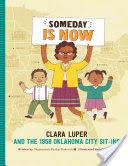
Our collection of picture books featuring Black and Indigenous people and People of Color (BIPOC) is available to the public. *Inclusion of a title in the collection DOES NOT EQUAL a recommendation.* Click here for more on book evaluation.
Find titles using a keyword search below (e.g. adoption, birthday, holidays, etc.), or by selecting one or a combination of filters on the lefthand sidebar below.
First time here? Start here!
51 matching books
Show FiltersFilter Results
-
Any Child 10
-
Biography 30
-
Cross Group 51
-
Fiction 20
-
Non-Fiction 30
-
Boy/Man 35
-
Girl/Woman 36
-
Joint Main 12
-
Secondary 36

Libba
Elizabeth Cotten was only a little girl when she picked up a guitar for the first time. It wasn't hers (it was her big brother's), and it wasn't strung right for her (she was left-handed). But she flipped that guitar upside down and backwards and taught herself how to play it anyway. By age eleven, she'd written "Freight Train," one of the most famous folk songs of the twentieth century. And by the end of her life, people everywhere from the sunny beaches of California to the rolling hills of England knew her music.

Saffron Ice Cream
Rashin is an Iranian immigrant girl living in New York, excited by her first trip to Coney Island, and fascinated by the differences in the beach customs between her native Iran and her new home--but she misses the saffron flavored ice cream that she used to eat.

Someday is now
Presents the life of Clara Luper, an African-American teacher and local civil rights leader who taught her students about equality and led them in lunch counter sit-in demonstrations in Oklahoma City in 1958.

A moon for Moe and Mo
Moses Feldman and Mohammed Hassan both live on Flatbush Avenue, but when they meet at the grocery store they quickly become best friends, sharing a picnic while their families prepare for the holidays of Rosh Hashanah and Ramadan.

Trailblazer
"This beautiful picture book tells the little-known story of Raven Wilkinson, the first African American woman to dance for a major classical ballet company and an inspiration to Misty Copeland. When she was only five years old, her parents took her to see the Ballet Russe de Monte Carlo. Raven perched on her crushed velvet seat, heard the tympani, and cried with delight even before the curtain lifted. From that moment on, her passion for dance only grew deeper inside of her. No black ballerina had ever danced with a major touring troupe before. Raven would be the first. Raven Wilkinson was born on February 2, 1935, in New York City. From the time she was a little girl, all she wanted to do was dance. On Raven's ninth birthday, her uncle gifted her with ballet lessons, and she completely fell in love with dance. While she was a student at Columbia University, Raven auditioned for the Ballet Russe de Monte Carlo and was finally accepted on her third try, even after being told she couldn't dance with them because of her skin color. When she started touring with her troupe in the United States in 1955, Raven encountered much racism in the South, but the applause, alongside the opportunity to dance, made all the hardship worth it. Several years later she would dance for royalty with the Dutch National Ballet and regularly performed with the New York City Opera until she was fifty. This beautiful picture book tells the uplifting story of the first African American woman to dance for a major classical ballet company and how she became a huge inspiration for Misty Copeland. Theodore Taylor III's unique, heavy line style of illustration brings a deeper level of fluidity and life to the work, and Misty Copeland's beautifully written foreword will delight ballet and dance fans of all ages"--Provided by publisher

Ella
"The inspiring, true story of how a remarkable friendship between Ella Fitzgerald and Marilyn Monroe was born - and how they worked together to overcome prejudice and adversity"--Book jacket

Schomburg: The man who built a library
Where is our historian to give us our side? Arturo asked. Amid the scholars, poets, authors, and artists of the Harlem Renaissance stood an Afro-Puerto Rican named Arturo Schomburg. This law clerk's life's passion was to collect books, letters, music, and art from Africa and the African diaspora and bring to light the achievements of people of African descent through the ages. When Schomburg's collection became so big it began to overflow his house (and his wife threatened to mutiny), he turned to the New York Public Library, where he created and curated a collection that was the cornerstone of a new Negro Division. A century later, his groundbreaking collection, known as the Schomburg Center for Research in Black Culture, has become a beacon to scholars all over the world

Two friends
This story imagines what it was like when Susan B. Anthony and Frederick Douglass got together for a cup of tea and discussed their struggle for civil rights.

Strange fruit
"The audience was completely silent the first time Billie Holiday performed a song called “Strange Fruit.” In the 1930s, Billie was known as a performer of jazz and blues music, but this song wasn’t either of those things. It was a song about injustice, and it would change her life forever. Discover how two outsiders—Billie Holiday, a young black woman raised in poverty, and Abel Meeropol, the son of Jewish immigrants—combined their talents to create a song that challenged racism and paved the way for the Civil Rights movement." -- publisher

Frederick’s journey
Traces Frederick Douglass's journey from slavery to international renown as writer and lecturer
